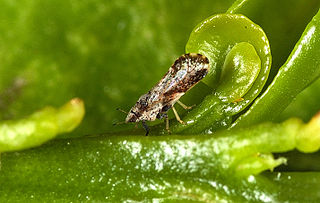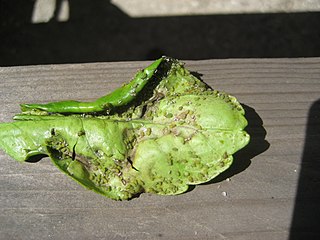
Hemiptera is an order of insects, commonly called true bugs, comprising over 80,000 species within groups such as the cicadas, aphids, planthoppers, leafhoppers, assassin bugs, bed bugs, and shield bugs. They range in size from 1 mm (0.04 in) to around 15 cm (6 in), and share a common arrangement of piercing-sucking mouthparts. The name "true bugs" is often limited to the suborder Heteroptera.

The Pentatomoidea are a superfamily of insects in the Heteroptera suborder of the Hemiptera order. As Hemiptera, they share a common arrangement of sucking mouthparts. The roughly 7000 species under Pentatomoidea are divided into 21 families. Among these are the stink bugs and shield bugs, jewel bugs, giant shield bugs, and burrower bugs.

Citrus production encompasses the production of citrus fruit, which are the highest-value fruit crop in terms of international trade. There are two main markets for citrus fruit:

Psyllidae, the jumping plant lice or psyllids, are a family of small plant-feeding insects that tend to be very host-specific, i.e. each plant-louse species only feeds on one plant species (monophagous) or feeds on a few closely related plants (oligophagous). Together with aphids, phylloxerans, scale insects and whiteflies, they form the group called Sternorrhyncha, which is considered to be the most "primitive" group within the true bugs (Hemiptera). They have traditionally been considered a single family, Psyllidae, but recent classifications divide the group into a total of seven families; the present restricted definition still includes more than 70 genera in the Psyllidae. Psyllid fossils have been found from the Early Permian before the flowering plants evolved. The explosive diversification of the flowering plants in the Cretaceous was paralleled by a massive diversification of associated insects, and many of the morphological and metabolic characters that the flowering plants exhibit may have evolved as defenses against herbivorous insects.

Citrus greening disease is a disease of citrus caused by a vector-transmitted pathogen. The causative agents are motile bacteria, Liberibacter spp. The disease is vectored and transmitted by the Asian citrus psyllid, Diaphorina citri, and the African citrus psyllid, Trioza erytreae, also known as the two-spotted citrus psyllid. It has no known cure. It has also been shown to be graft-transmissible. Three different types of HLB are currently known: the heat-tolerant Asian form, and the heat-sensitive African and American forms. The disease was first described in 1929 and first reported in China in 1943. The African variation was first reported in 1947 in South Africa, where it is still widespread. Eventually, it affected the United States, reaching Florida in 2005. Within three years, it had spread to the majority of citrus farms. The rapid increase in this disease has threatened the citrus industry not only in Florida, but the entire US. As of 2009, 33 countries have reported HLB infection in their citrus crop.

An orange is a fruit of various citrus species in the family Rutaceae ; it primarily refers to Citrus × sinensis, which is also called sweet orange, to distinguish it from the related Citrus × aurantium, referred to as bitter orange. The sweet orange reproduces asexually ; varieties of sweet orange arise through mutations.

A planthopper is any insect in the infraorder Fulgoromorpha, in the suborder Auchenorrhyncha, a group exceeding 12,500 described species worldwide. The name comes from their remarkable resemblance to leaves and other plants of their environment and that they often "hop" for quick transportation in a similar way to that of grasshoppers. However, planthoppers generally walk very slowly. Distributed worldwide, all members of this group are plant-feeders, though few are considered pests. The infraorder contains only a single superfamily, Fulgoroidea. Fulgoroids are most reliably distinguished from the other Auchenorrhyncha by two features; the bifurcate ("Y"-shaped) anal vein in the forewing, and the thickened, three-segmented antennae, with a generally round or egg-shaped second segment (pedicel) that bears a fine filamentous arista.

Murraya paniculata, commonly known as orange jasmine, orange jessamine, china box or mock orange, is a species of shrub or small tree in the family Rutaceae and is native to South Asia, Southeast Asia and Australia. It has smooth bark, pinnate leaves with up to seven egg-shaped to elliptical leaflets, fragrant white or cream-coloured flowers and oval, orange-red berries containing hairy seeds.

Honey wasps are species in the genus Brachygastra of the family Vespidae. Brachygastra comprises 17 species of social paper wasps. The ancestral species are thought to have diverged about 32 million years ago within diverse Amazonian rainforest. Subsequent speciation within the genus is thought to have mostly occurred between 23 Ma and 10 Ma, during the time of the Andean uplift when the landscape was significantly altered due to tectonic activity. The current cladistic organisation of the genus has been heavily reliant on morphological characteristics.

Brachygastra mellifica, commonly known as the Mexican honey wasp, is a neotropical social wasp. It can be found in North America. B. mellifica is one of few wasp species that produces honey. It is also considered a delicacy in some cultures in Mexico. This wasp species is of use to humans because it can be used to control pest species and to pollinate avocados.

Coccinella transversalis, commonly known as the transverse ladybird or transverse lady beetle is a species of ladybird beetle found from India across southern and southeastern Asia to Malesia and Australia. It is not to be confused with Coccinella transversoguttata, a widespread species in Europe and North America also known as the transverse ladybird. The alternative vernacular of small transverse ladybird may be used for C. transversalis in instances where these two species are discussed together.

Encarsia is a large genus of minute parasitic wasps of the family Aphelinidae. The genus is very diverse with currently about 400 described species and worldwide distribution. The number of existing species is expected to be several times higher because many species are still undescribed. Encarsia is a very complex genus, with specimens showing both inter- and intra-specific variations, making morphological classification difficult.

Diaphorina citri, the Asian citrus psyllid, is a sap-sucking, hemipteran bug in the family Psyllidae. It is one of two confirmed vectors of citrus greening disease. It has a wide distribution in southern Asia and has spread to other citrus growing regions.

The African citrus psyllid is a sap-sucking insect, a hemipteran bug in the family Triozidae. It is an important pest of citrus, being one of only two known vectors of the serious citrus disease, huanglongbing or citrus greening disease. It is widely distributed in Africa. The other vector is the Asian citrus psyllid, Diaphorina citri.

Liberibacter is a genus of Gram-negative bacteria in the Rhizobiaceae family. Detection of the liberibacteria is based on PCR amplification of their 16S rRNA gene with specific primers. Members of the genus are plant pathogens mostly transmitted by psyllids. The genus was originally spelled Liberobacter.

Planococcus citri, commonly known as the citrus mealybug, is a species of mealybugs native to Asia. It has been introduced to the rest of the world, including Europe, the Americas, and Oceania, as an agricultural pest. It is associated with citrus, but it attacks a wide range of crop plants, ornamental plants, and wild flora.

Cyantraniliprole is an insecticide of the ryanoid class, specifically a diamide insecticide. It is approved for use in the United States, Canada, China, and India. Because of its uncommon mechanism of action as a ryanoid, it has activity against pests such as Diaphorina citri that have developed resistance to other classes of insecticides.

Tamarixia radiata, the Asian citrus cyllid parasitoid, is an hymenopteran wasp from the family Eulophidae which was discovered in the 1920s in the area of northwestern India (Punjab), now Pakistan. It is a parasitoid of the Asian citrus psyllid, an economically important pest of citrus crops around the world and a vector for Citrus greening disease.

Lycorma is a genus of planthoppers native to Asia. The first species within the genus was described by Frederick William Hope in 1843 and the genus was formally established by Carl Stål in 1863.

Chilocorus cacti, known generally as the cactus lady beetle or the twice-stabbed cactus lady beetle, is a species of lady beetle in the family Coccinellidae. It is native to the Caribbean region, North America, Central America, and South America. The adults and larvae feed on scale insects and attempts have been made to use it for biological pest control.




















